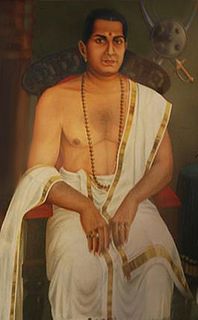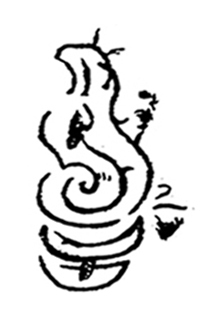
Pazhassi Raja was known as Kerala Varma and was also known as Cotiote Rajah and Pychy Rajah. He was a warrior Hindu prince and de facto head of the kingdom of Kottayam, otherwise known as Cotiote, in Malabar, India, between 1774 and 1805. His struggles with the British East India Company is known as the Cotiote War. He is popularly known as Kerala Simham on account of his martial exploits.

The Polygar Wars or Palaiyakkarar Wars were wars fought between the Polygars (Palaiyakkarars) of the former Tirunelveli Kingdom in Tamil Nadu, India and the British East India Company forces between March 1799 to May 1802 or July 1805. The British finally won after carrying out gruelling protracted jungle campaigns against the Polygar armies. Many lives were lost on both sides and the victory over the Polygars brought large parts of the territories of Tamil Nadu under British control, enabling them to get a strong hold in Southern India.

Venad was a medieval kingdom lying between the Western Ghat mountains and the Arabian Sea on the south-western tip of India with its headquarters at the port city of Kollam/Quilon. It was one of the major principalities of Kerala, along with kingdoms of Kannur (Kolathunadu), Kozhikode (Nediyiruppu), and Kochi (Perumpadappu) in medieval and early modern period.

Malabar District, also known as Malayalam District, was an administrative district on the southwestern Malabar Coast of Bombay Presidency (1792-1800) and Madras Presidency (1800-1947) in British India, and independent India's Madras State (1947-1956). It was the most populous and the third-largest district in the erstwhile Madras State. The British district included the present-day districts of Kannur, Kozhikode, Wayanad, Malappuram, Palakkad, Chavakad Taluk and parts of Kodungallur Taluk of Thrissur district, and Fort Kochi area of Ernakulam district in the northern and central parts of present Kerala state, the Lakshadweep Islands, and a major portion of the Nilgiris district in Tamil Nadu. The detached settlements of Tangasseri and Anchuthengu, which were British colonies within the kingdom of Travancore in southern Kerala, also formed part of Malabar District until 1927. Malayalam was administrative as well as most spoken Lingua franca of Malabar District during British Rule. Jeseri, a distinct dialect of Malayalam, was spoken in the Laccadive Islands. Malabar District merged with the erstwhile state of Travancore-Cochin (1950-1956) to form Kerala according to the States Reorganisation Act, 1956. On the same day, the present Kasaragod district of South Canara District was also attached to Malabar, and the Laccadive&Minicoy Islands of Malabar were reorganised to form a new Union Territory. Malabar was trifurcated to form the districts of Kannur, Kozhikode, and Palakkad, on 1 January 1957.
Kottayam-Malabar is a census town near Kuthuparamba in Kannur district of Kerala state in India. It is different from the city of Kottayam in Kottayam district of the same state.

Kerala Varma Pazhassi Raja is a 2009 Indian Malayalam-language epic period drama film based on the life of Pazhassi Raja, a king who fought against the East India Company in the 18th century. The film was directed by Hariharan, written by M. T. Vasudevan Nair and produced by Gokulam Gopalan. It stars Mammootty with Sarathkumar, Manoj K Jayan, Suresh Krishna, Suman, Kanika Subramaniam, Padmapriya, Thilakan and Jagathi Sreekumar in supporting roles. The music score and soundtrack were created by Ilaiyaraaja, while its sound design is by Resul Pookutty. The film received an overwhelming response and it has emerged as one of the top grossers in Kerala’s box office history.
"Aswathi Thirunal" Umayamma, known as Queen Umayamma or Queen Ashure (Aswathi),, was the regent queen of Venad (Venatu) in southern India from 1677 to 1684 on behalf of her young nephew Ravi Varma. She also served as the Junior Queen of Attingal under Senior Queen Makayiram Thirunal and subsequently as the Senior Queen of Attingal.

The Travancore royal family was the ruling house of the Kingdom of Travancore. They gave up their ruling rights in 1949 when Travancore merged with India and their political pension privileges was abolished in 1971. The family are descended from the Ay/Venad family and the Chera dynasty.
Edachena Kunkan was a Wayanad Nair noble from Tirunelli, Wayanad, Kerala, India who joined the war effort of Pazhassi Raja during the 1770s and became commander of the Raja's army. His younger brothers joined him as generals. Kunkan was a popular leader in Wayanad, gathering support from people of many classes for Raja's war against the East India Company.

Kottayam (Cotiote) is a former vassal feudal city-state in the erstwhile province of Malabar in present-day Kerala, in the Indian subcontinent. Kottayam (Cotiote) is famed for Pazhassi Raja, one of the principal leaders of the Wayanad Insurrection. Pazhassi Raja was a member of the western branch of the Kottayam royal clan. When Hyder Ali of the Kingdom of Mysore occupied Malabar in 1773, the Raja of Kottayam found political asylum in Travancore. In 1790, the British recognized Pazhassi Raja as the head of Kottayam instead of the original Raja who had taken refuge at Travancore.
The Siege of Tellicherry was a military embargo that happened in Thalassery. The Commander in Chief of the Mysore Calicut Province, Sirdar Ali, took siege of the British Military Barrack of Thalassery for 18 months. They British and the local administrators were blockaded within Thalassery by land as well as by sea. It was during the Second Anglo-Mysore War. The siege continued until reinforcements from Bombay under the command of Major Abington attacked the Mysore army and defeated them. Major Abington then moved south, capturing Calicut. The Siege of Tellicherry led to the fall of strongholds of the First Mysore conquest, led by Hyder Ali. Even though laterTipu Sultan came from Mysore to reinstate the conquered area to previous status.

Pazhassi Raja is a 1964 Malayalam biographical film, directed and produced by Kunchako. It is written by well known playwright Thikkodiyan and is based on the life of warrior king Kerala Varma Pazhassi Raja. It stars Kottarakkara Sreedharan Nair in the title role, with Prem Nazir, Sathyan, Satyapal, S. P. Pillai, Rajashree and Pankajavalli in other important roles.
The British got Malabar from Tippu Sultan in 1792. But Malabar was a province that was plagued by refraction, unrest and insurgency as early as 1766—when Hyder Ali occupied whole of Malabar. Two decades of Mysore effort to subjugate this province ended up in chaos and confusion in Malabar with a part of her population either dead or migrated and once prosperous economy destroyed.
Kannavath Sankaran Nambiar was the prime minister, or Sarvadikaryakar, of Pazhassi Raja in what is today India. Sandkaran led rebel forces against the British East India Company in two campaigns before he was captured and executed.
Ravi Varma Raja (1745–1793) was a Samantan Nair warrior prince of the Royal House of Zamorins from Calicut who fought a two-decade long revolt against the Mysore Sultanate under Hyder Ali and Tipu Sultan between 1766–1768 and 1774–1791, and later the British East India Company in 1793.
Pazhayamviden Chandu was a general of Pazhassi Raja whose betrayal led to death of his Raja and British victory in Cotiote War.
Pallur Rayrappan was a supporter of Kerala Varma Pazhassi Raja of Kerala, India, who fought a guerrilla-type war against the British East India Company during first decade of the 19th century.

Kannur, formerly known in English as Cannanore, Arabic as Kannanur, and Portuguese as Cananor, is a city and a Municipal Corporation in North Malabar region, state of Kerala, India. It is the largest city in North Malabar, which is the northernmost region of Kerala. It is sometimes identified Kolathunadu, which was ruled by the Kolathiris. In the 12th and 13th centuries there was trade with Persia and Arabia.
Wayanad district, which is home to Edakkal Caves, has human settlement from prehistoric era. Wayanad is the sole Plateau in Kerala. The tribal dialects of Wayanad like the Ravula language and the Paniya language are closely related to Malayalam.
Thalassery was a trade hub where Chinese, Arab, and Jewish traders had considerable influence in the spice market before that the Greeks and Romans was in the trade. It was the European invasion that brought significant change as they enforced the trade with their military.







